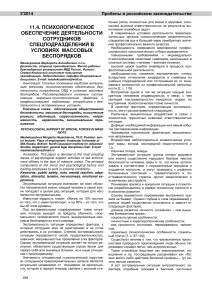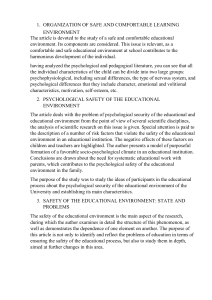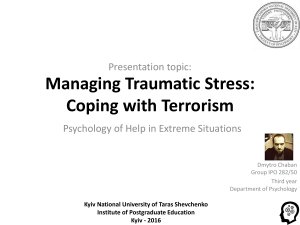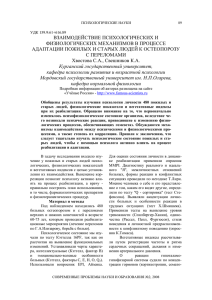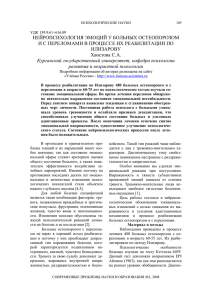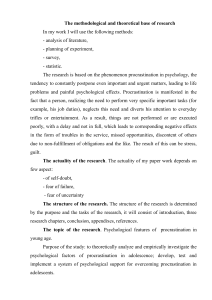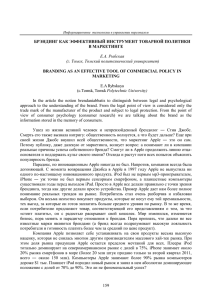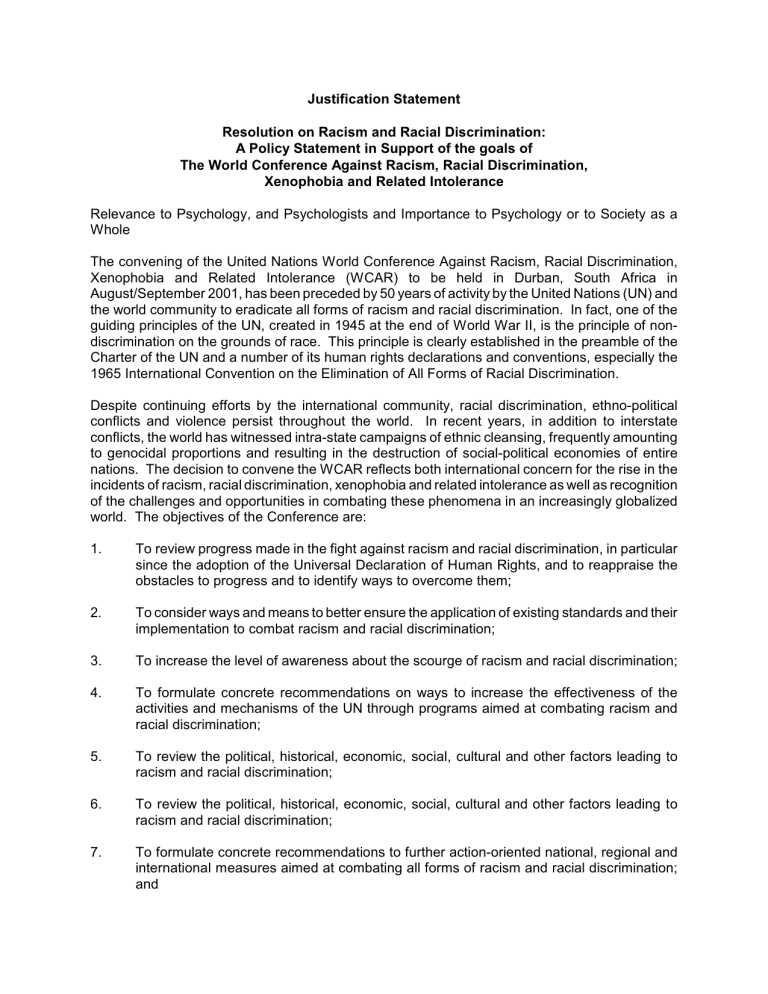
Justification Statement Resolution on Racism and Racial Discrimination: A Policy Statement in Support of the goals of The World Conference Against Racism, Racial Discrimination, Xenophobia and Related Intolerance Relevance to Psychology, and Psychologists and Importance to Psychology or to Society as a Whole The convening of the United Nations World Conference Against Racism, Racial Discrimination, Xenophobia and Related Intolerance (WCAR) to be held in Durban, South Africa in August/September 2001, has been preceded by 50 years of activity by the United Nations (UN) and the world community to eradicate all forms of racism and racial discrimination. In fact, one of the guiding principles of the UN, created in 1945 at the end of World War II, is the principle of nondiscrimination on the grounds of race. This principle is clearly established in the preamble of the Charter of the UN and a number of its human rights declarations and conventions, especially the 1965 International Convention on the Elimination of All Forms of Racial Discrimination. Despite continuing efforts by the international community, racial discrimination, ethno-political conflicts and violence persist throughout the world. In recent years, in addition to interstate conflicts, the world has witnessed intra-state campaigns of ethnic cleansing, frequently amounting to genocidal proportions and resulting in the destruction of social-political economies of entire nations. The decision to convene the WCAR reflects both international concern for the rise in the incidents of racism, racial discrimination, xenophobia and related intolerance as well as recognition of the challenges and opportunities in combating these phenomena in an increasingly globalized world. The objectives of the Conference are: 1. To review progress made in the fight against racism and racial discrimination, in particular since the adoption of the Universal Declaration of Human Rights, and to reappraise the obstacles to progress and to identify ways to overcome them; 2. To consider ways and means to better ensure the application of existing standards and their implementation to combat racism and racial discrimination; 3. To increase the level of awareness about the scourge of racism and racial discrimination; 4. To formulate concrete recommendations on ways to increase the effectiveness of the activities and mechanisms of the UN through programs aimed at combating racism and racial discrimination; 5. To review the political, historical, economic, social, cultural and other factors leading to racism and racial discrimination; 6. To review the political, historical, economic, social, cultural and other factors leading to racism and racial discrimination; 7. To formulate concrete recommendations to further action-oriented national, regional and international measures aimed at combating all forms of racism and racial discrimination; and 2 8. To draw up concrete recommendations to ensure that the UN has the necessary resources for its activities to combat racism and racial discrimination. In consideration of the current and historical contexts and goals of the WCAR, the proposed resolution, as a policy statement in support of the goals of the United Nation’s World Conference Against Racism, Racial Discrimination, Xenophobia and Related Intolerance is both relevant and important for the following reasons: ! First, the resolution is consonant with APA's overarching purpose to advance psychology as a science and as a profession, dedicated to understanding commonalties and differences in human behavior and promoting human development and welfare. As such, the resolution is intended to serve as a catalyst within APA's national and international membership for reducing interpersonal, institutional and societal sources and consequences of racism. ! Second, the resolution is supported by a vast body of United States and international psychological research, accumulated over more than half a century. Knowledge of human behavioral and psychological principles is of critical importance to fulfilling several of the goals of the WCAR, including the development and implementation of effective national and international policies and programs against racism. ! Third, the resolution seeks to build upon APA's policies and programs against discrimination on the basis of race and APA's efforts to support the struggle against racism and other forms of intolerance. ! Fourth, the resolution is consistent with APA's purposes in seeking accreditation as a nongovernmental organization (NGO) at the United Nations (UN). Under the guidelines for NGO participation, APA shares the commitment with other accredited NGOs to disseminate information about the UN and global issues to APA members and affiliates throughout the world and to contribute its expertise and resources toward addressing the challenges of global transformation. Quality and Quantity of Psychological Data and Conceptualization Relevant to the Resolution Racism, racial intolerance, and xenophobia have permeated the research agendas of psychologists for decades. For example, psychologists have developed major programs of research focused on such topics as: ! ! The prevalence of racism, racial intolerance , prejudice and related acts of power, violence, and fear (Hawley & Jackson, 1995; Katz, 1991; Fritzsche, 1994; Schuman, Steeh & Bobo, 1985; Schutte, 1995; Smith, 1974; Sniderman & Piazza, 1993; Thomas, 1995; Katz & Taylor, 1988); the insidious nature of their expression (Gaertner & Dovidio, 1986; Kaplan & Rogers, 1994; Rosenbaum, 1992; Baird & Rosenbaum, 1992); 3 ! the measurement of related attitudes, dispositions, and personality (Duckitt, 1993; 1991; Dunbar, 1995; Eisenman, 1993; Kleinpenning & Hagendoorn, 1993; Landrine & Klonoff, 1996; Fazio, Jackson, Dunton, & Williams, 1995); ! and the profound and penetrating impact of these experiences on children (Mane, 1993; Powlishta, Serbin, Doyle, & White, 1994; Boushel, 1994), ! adults (Herbert, 1990 ), the elderly (Kastenbaum, 1991), ! families (Boyd-Franklin, 1993), schools (Ford, 1990; King, 1991), ! colleges (Farrell & Jones, 1988; Feagin, 1992; McCormack, 1995), ! various cultural groups (Lempert & Monsma, 1994; Deyhle, 1995; Hsai, 1986; Ojanuga, 1993; Ray, 1988, 1990; Roberts, 1988), ! countries of the world (Stones, 1994; Streicker, 1995; Verkuyten & Masson, 1995;Wetherell & Potter, 1992), ! the world of work (Feagin & Imani, 1994; McConahay, 1983; Okocha, 1994; Sidanius, Pratto, Martin, & Stallworth, 1991; Sidanius & Pratto, 1993; Telles, 1994; Yamato, 1994), ! politics (Drew, 1982; Green & Waxman, 1987; Hagen, 1995, Koocher, 1994;Laird, 1994; Moskowitz & Stroh, 1994), ! the legal system (Fukurai, Buler & Krooth, 1991; Goetting, 1985; Lipton, 1983; Pfeifer & Ogloff, 1991), ! the healthcare system (Byrd, 1990; Cully, 1996; Funkhouser, Moser, 1990; Glastra & Kats, 1992), ! mental health (Jones, 1992), ! religion (Herek, 1987; Spaights, 1991), ! the media (Kellner, Hall, Pieterse, Hooks, Rhodes, Ehrenreich, Lipsitz, Bobo, & Gross, 1991) and ! sports (Ashe, 1988; Brooks & Althouse, 1993). Most studies and other scholarly discourse on the topics of racism, racial intolerance, and xenophobia have focused on the victim, with particular attention given to the impact acts of racial aggression have had on their lives. Contemporary scholarship in this area has increasingly focused on the strengths, growth, and healing of the survivor. The study of perpetrators as individuals or groups who engage in these forms of aggressive experiences have received less, though significant, attention in the literature. Considerably less attention has been devoted to studying the immediate and extended families of the victim, particularly the emotional, psychological and sometimes physiological aftermath that now challenges their lives. The communities wherein the 4 victims reside may also struggle with the emotional upheaval caused by acts of racism, racial intolerance and xenophobia. Ongoing research that aims at identifying the factors contributing to the successful or less than satisfactory regrouping of the impacted communities seems warranted. Finally, the consequential aftermath experienced by the immediate and extended families and communities of the perpetrators of racial hatred also merits closer psychological investigation. Likely Degree of Consensus Among APA Constituents The overwhelming majority of the constituencies of the American Psychological Association are likely to strongly endorse the resolution on Racism and Racial Discrimination… . To a large extent, this is due to the strong psychological research base related to these issues. Early work in social psychology indicated how stereotyping and prejudice lead to the development of racist attitudes and behavior. Social psychologists also provided models of how racist attitudes could be prevented. These and other related psychological research have served to guide and justify APA’s involvement in a broad agenda of related activities. For example, APA’s former President Martin Seligman, PhD, encouraged APA’s involvement in efforts related to ethno-political warfare and peace (which is also an issue of central concern to the Society for the Study of Peace, Conflict and Violence–APA Division 48), while APA former President Richard Suinn, PhD, dedicated the 1999 APA convention to racial and other diversity issues. APA’s Office of Ethnic Minority Affairs sponsored a major 1997 mini-convention on Psychology and Racism and a continuing APA National Conversation on Psychology and Racism. Additionally, APA has seeks to eliminate racism and promote diversity within its own organizational structure by promoting the inclusion of ethnic minorities, including establishing an Office and Committee on Ethnic Minority Affairs and the Society for the Psychological Study of Ethnic Minority Issues (APA Division 45). In addition, APA actively seeks to increase the number of ethnic minority psychologists through its sustained support of the APA Minority Fellowship Program for over 25 years. These and other past and ongoing initiatives by APA are evidence of the longstanding importance of issues of racism and anti-racism to psychologists, as well as the broad support and consensus that exist among diverse APA constituencies for the proposed resolution on Racism and Racial Discrimination. Likelihood of the Resolution Having a Constructive Impact on Public Opinion/Policy, Assessment, Consultation and Training APA is a global organization (Rosenweig, 1992). Taking a public stand against racism, in all its forms and manifestations, deploring the continuing exploitation of all peoples based upon racial background, can have profound influences upon public opinion. We have learned over the years that through public outreach the APA can play a very constructive role in educating the public (e.g. Feinberg, 2000). Taking a principled stand against the worse of the human experience cannot but help in providing a solid public image and the opportunity for delivering a clear message on the fundamental human values shared by members of APA. In addition to the direct effects in advertising, testimony, public materials, a firm and aggressive stance will also have a positive effect on the development of research and research base that directly attacks the fundamental aspects of the cognitive, social and affective bases in stereotyping, bigotry and prejudice that support individual and interpersonal dimensions of the problem (Aboud & Levy, 1999). In addition, through work that targets the institutional support mechanisms and cultural bases of racism and discrimination (e.g. Jones, 1997), the public stance can help in furthering the nature of empirical research (Aboud & Levy, 1999). Finally, through processes of education and accreditation, the APA can begin to legitimately have training modules and programs that include the ways in which 5 the fundamental education of psychologist can be influenced to reflect greater attention to the problem of racism and discrimination and their influence on problems of well-being and positive psychological functioning (Boyd-Franklin, 1988; Herrell, Merritt & Kalu, 1998; Pedersen, 2000). As has been made clear in prior research, ethnic and racial minorities are not the only victims of racism (e.g. Jackson & Inglehart, 1995), and societies in which such bigotry and expressions of hatred are tolerated are in general less successful in providing for the material, social and psychological well-being of all of its citizens (United Nations, 1994). APA can take the lead in thinking about community consultation models that address the needs of the victims of racism and discrimination (Sue, 1991). Similar to the interventions now targeted for schools that are the objects of violence, programs can be designed to address circumstances, like the recent situations in Cincinnati and in New York City involving police killings of unarmed racial minorities (Hawley, Banks, Padilla, Pope-Davis & Schofield, 1995). Workshops at meetings and conventions, special educational programs for continuing education credits, and concern with ways of addressing individual racism and discriminatory practices, are all reasonable and acceptable ways of thinking about maximizing individual well-being (Franklin & Jackson, 1990) and the overall objective of a global psychological organization like the APA (Rosenweig, 1992) References Aboud, F. E. & Levy, S. R. (1999). Introduction: Are we ready to translate research into programs? Journal of Social Issues, 55 (4), 621-626. Baird, R.M. & Rosenbaum, S.E. (1992). Bigotry, prejudice and hatred: Definitions, causes and solutions. Buffalo: Prometheus Books. Boushel, M. (1994). The protective environment of children: Towards a framework for antioppressive, cross-cultural and cross-national understanding. British Journal of Social Work, 24, 173-190. Boyd-Franklin, N. (1989). Black families in therapy: A multisystems approach. New York: Guilford. Boyd-Franklin, N. (1993). Racism, secret-keeping, and African-American families. In E. ImberBlack (Ed.), Secrets in families and family therapy (pp. 331-354). New York: W.W.Norton. Byrd, W.M. (1990). Race, biology, and health care: reassessing a relationship. Journal of Health Care for the Poor and Underserved, 1(3), 278-296. Culley, L. (1996). A critique of multiculturalism in health care: the challenge for nurse education. Journal of Advanced Nursing, 23(3), 564-570. Deyhle, D. (1995). Navajo youth and Anglo racism: Cultural integrity and resistance. Harvard Educational Review, 65(3), 403-444. Drew, J.S. (1982). Death in the afternoon: Personal invective and bigotry in Congress forty years ago. Papers in the Social Sciences, 2, 71-79. 6 Duckitt, J. (1993). Further validation of a subtle racism scale in South Africa. South African Journal of Psychology, 23, 116-119. Duckitt, J. (1991). Prejudice and racism. In D. Foster and J. Louw-Potgieter (Eds.), Social psychology in South Africa, (pp. 171-203). Johannesburg: Lexicon Publishers. Dunbar, E. (1995). The prejudiced personality, racism, and anti-Semitism: the PR scale forty years later. Journal of Personality Assessment, 65(2), 270-277. Eisenman, R. (1993). Student attitudes toward David Duke before and after seeing the film “Who is David Duke?” Bulletin of the Psychonomic Society, 31, 37-38. Farrell, W.C. & Jones, C.K. (1988). Recent racial incidents in higher education: A preliminary perspective. Urban Review, 20, 211-226. Fazio, R.H., Jackson, J.R., Dunton, B.C. & Williams, C.J. (1995). Variability in automatic activation as an unobtrusive measure of racial attitudes: a bona fide pipeline? Journal of Personality and Social Psychology, 69(6), 1013-1027.Feagin, J.R. (1992). The continuing significance of racism: Discrimination against Black students in White colleges. Journal of Black Studies, 22, 546-578. Feinberg, M. (2000). Racism and psychology: Why we dislike, stereotype, and hate other groups and what to do about it. Washington, DC: Office of Minority Affairs, American Psychological Association. Feagin, J.R. & Imani, N.O. (1994). Racial barriers to African American entrepreneurship: An exploratory study. Social Problems, 41, 562-584. Ford, C.A. (1990). Educational problems of Blacks in urban America: Historical, contemporary and futuristic perspectives. Western Journal of Black Studies, 14, 90-99. Franklin, A. J., & Jackson, J. S. (1990). Factors contributing to positive mental health among black Americans. In D. Smith-Ruiz (Ed.), Handbook of black mental health and mental disorder among black Americans (pp. 291-307). Westport, CT: Greenwood Press. Fritzsche, K. P. (1994). Conditions for xenophobia in eastern Germany (formerly the GDR). In R. F. Farmen (Ed.), Nationalism, ethnicity and identity: Cross national and comparative perspectives (pp. 277-284). New Brunswick: Transaction Publishers. Fukurai, H., Butler, E.W. & Krooth, R. (1991). Where did all the Black jurors go? A theoretical synthesis of racial disenfranchisement in the jury system and jury selection. Journal of Black Studies, 22, 196-215. Funkhouser, S.W. & Moser, D.K. (1990). Is health care racist? ANS-Advanced Nursing Science, 12(2), 47-55. 7 Gaertner, S. L. & Dovidio, J. F. (1986). The aversive form of racism. In S.L. Gaertner and J.F. Dovidio (Eds.), Prejudice, discrimination, and racism (pp. 61-89). Orlando: Academic Press. Glastra, F.J. & Kats, E. (1992). Culturalizing the ethnic patient: Educational films and images of interethnic relations in health care. Special issue: Qualitative research. Health Education Research, 7, 487-496. Goetting, A. (1985). Racism, sexism, and ageism in the prison community. Federal Probation, 49, 10-22. Green, D.P. & Waxman, L.M. (1987). Direct threat and political tolerance: An experimental analysis of the tolerance of Blacks toward racists. Public Opinion Quarterly, 51, 149-165. Hagen, M.G. (1995). References to racial issues. Political Behavior, 17, 49-88. Harrell, J.,Merritt, M.M. & Kalu, J. (1998). Racism, stress and disease. In (ed.). R. L. . Jones. African American mental health. Hampton, VA: Cobb & Henry. Hawley, W. D., Banks, J. A., Padilla, A. A., Pope-Davis, D. B. & Schofield, J. W. (1995). Strategies for reducing racial and ethnic prejudice: Essential principles for program design. In W. D. Hawley & A. W. Jackson (eds.), Toward a common destiny: Improving race and ethnic relations in America. San Francisco, CA: Jossey-Bass. Hawley, W.D. & Jackson, A.W. (1995). Toward a common destiny: Improving race and ethnic relations in America. San Francisco: Jossey-Bass Publishers. Herbert, J.I. (1990). Integrating race and adult psychosocial development. Organizational Behavior, 11, 433-446. Journal of Herek, G.M. (1987). Religious orientation and prejudice: A comparison of racial and sexual attitudes. Personality and Social Psychology Bulletin, 13, 34-44. Jackson, J. S. & Inglehart, M. R. (1995). Reverberation theory: Stress and racism in hierarchically structured communities. In S.E. Hobfoll & M.W. deVries (Eds.), Extreme Stress and communities: Impact and Intervention, (pp. 353-373). Dordrecht, the Netherlands: Kluwer Academic Publishers. Jones, J.M. (1992). Understanding the mental health consequences of race: Contributions of basic social psychological processes. In D.N. Ruble, P.R. Costanzo and M.E. Oliveri (Eds.), The social psychology of mental health: Basic mechanisms and applications (pp. 199-240). New York: Guilford Press. Kaplan, G. & Rogers, L.J. (1994). Race and gender fallacies: The paucity of biological determinist explanations of difference. Challenging racism and sexism: Alternatives to genetic explanations (pp. 66-92). New York: Feminist Press at The City University of New York. 8 Kastenbaum, R. (1991). Racism and the older voter? Arizona’s rejection of a paid holiday to honor Martin Luther King. International Journal of Aging and Human Development, 32, 199-209. Katz, I. (1991). Gordon Allport’s The Nature of Prejudice. Political Psychology, 12, 125-157. Katz, P. A. & Taylor, D. A. (1988). Eliminating racism: Profiles in controversy. New York: Plenum Press. Kellner, D., Hall, S., Pieterse, J.N., Hooks, B., Rhodes, J., Ehrenreich, B., Lipsitz, G., Bobo, J. & Gross, L. A cultural studies approach to gender, race and class in the media. In G. Dines and J.M. Humez (Eds.), (1991). Gender, race, and class in the media: A text-reader (pp. 1-69). Thousand Oaks: Sage Publications. Kleinpenning, G. & Hagendoom, L. (1993). Forms of racism and the cumulative dimension of ethnic attitudes. Social Psychology Quarterly, 56, 21-36. King, J.E. (1991). Dysconscious racism: Ideology, identity, and the miseducation of teachers. Journal of Negro Education, 60, 133-146. Koocher, G.P. (1994). Case vignette: Racism and political correctness. Ethics and Behavior, 4,389. Laird, M. (1994). Political correctness commentary. Ethics and Behavior, 4, 390-394. Landrine, H. & Klonoff, E.A. (1996). The Schedule of Racist Events: A Measure of Racial Discrimination and a Study of Its Negative Physical and Mental Health Consequences. Journal of Black Psychology, 22, 144-168. Lempert, R. & Monsma, K. (1994). Cultural differences and discrimination: Samoans before a public housing eviction board. American Sociological Review, 59, 890-910. Lipton, J.P. (1983). Racism in the jury box: The Hispanic defendant. Hispanic Journal of Behavioral Sciences, 5, 275-290. Mane, N. (1993). Children and hate: Hostility caused by racial prejudice. In V.P. Varma (Ed.), How and why children hate (pp. 113-123). London: Jessica Kingsley Publishers. McConahay, J.B., (1983). Modern racism and modern discrimination: The effects of race, racial attitudes, and context on simulated hiring decisions. Personality and Social Psychology Bulletin, 9, 551-558. McCormack, A.S. (1995). The changing nature of racism on college campuses: Study of discrimination at a northeastern public university. College Student Journal, 29, 150-156. Moskowitz, D. & Stroh, P. (1994). Psychological sources of electoral racism. Political Psychology, 15, 307-329. Ojanuga, D. (1993). The Ethiopian Jewish experience as Blacks in Israel. Journal of Black Studies, 24, 147-158. 9 Okocha, A.A.G. (1994). Preparing racial ethnic minorities for the work force 2000. Journal of Multicultural Counseling and Development, 22, 106-114. Pedersen, P. (2000). A handbook for developing multicultural awareness. 3rd Ed. Alexandria, VA: American Counseling Association. Pfeifer, J.E. & Ogloff, J.R. (1991). Ambiguity and guilt determinations: A modern racism perspective. Journal of Applied Social Psychology, 21, 1713-1725. Powlishta, K.K., Serbin, L.A., Doyle, A.B. & White, D.R. (1994). Gender, ethnic, and body type biases: The generality of prejudice in childhood. Developmental Psychology, 30, 526-536. Ray, J.J. (1990). Racism, conservatism and social class in Australia: With German, Californian and South African comparisons. Personality and Individual Differences, 11, 187-189. Ray, J.J. (1988). Racism and personal adjustment: Testing the Bagley hypothesis in Germany and South Africa. Personality and Individual Differences, 9, 685-686. Roberts, A.E. (1988). Racism sent and received: Americans and Vietnamese view one another. In C.B. Marrett and C. Leggon (Eds.), Research in race and ethnic relations: A research annual, Vol. 5. (pp. 75-97). Greenwich: JAI Press. Rosenbaum, S.E. (Eds.). (1992). Bigotry, prejudice and hatred: Definitions, causes and solutions. Buffalo: Prometheus Books. Rosenweig, M. R. (1992). Introduction: What is psychological science? In (ed.) M. R. Rosenweig, International psychological science: Progress, problems and prospects. Washington, D.C.: American Psychological Association. Schuman, H., Steeh, C. & Bobo, L. (1985). Racial attitudes in America: Trends and interpretations. Cambridge: Harvard University Press. Schutte, G. (1995). What racists believe: Race relations in South Africa and the United States. Thousand Oaks: Sage Publications. Sidanius, J., Pratto, F., Martin, M. & Stallworth, L.M. (1991). Consensual racism and career track: Some implications of social dominance theory. Political psychology, 12, 691-721. Sidanius, J. & Pratto, F. (1993). Racism and support of free-market capitalism: A cross-cultural analysis. Political Psychology, 14, 381-401. Smith, C. H. (1974). Institutional racism: A major urban educational problem. Religious Education, 69, 713-727. Sniderman, P. M. & Piazza, T. (1993). The scar of race. Cambridge: Belknap Press/Harvard University Press. 10 Spaights, E. (1991). Racial prejudice toward Blacks among White churchgoers. Psychology: A Journal of Human Behavior, 28, 1-10. Stones, C.R. (1994). A social psychological and socio-historical perspective on change in South Africa. Journal of Social Behavior and Personality, 9, 845-856. Streicker, J. (1995). Policing boundaries: Race, class, and gender in Cartagena, Columbia. American Ethnologist, 22, 54-74. Sue, S. (1991). Ethnicity and culture in psychological research and practice. In (ed.) J, D. Goodchilds, Psychological perspectives on human diversity in America. Washington, D.C.: American Psychological Association. Telles, E.E. (1994). Industrialization and racial inequality in employment: The Brazilian example. American Sociological Review, 59, 46-63. Thomas, G. E. (Ed.), (1995). Race and ethnicity in America: Meeting the challenge in the 21stcentury. Washington, DC: Taylor & Francis. United Nations (1994). The United Nations and Apartheid: 1948-1994. New York: United Nations Department of Public Information. Verkuyten, M. & Masson, K. (1995). “New racism,” self-esteem, and ethnic relations among minority and majority youth in the Netherlands. Social Behavior and Personality, 23, 137154. Wetherell, M. & Potter, J. (1992). Mapping the language of racism: Discourse and the legitimization of exploitation. Chichester, England: Columbia University Press. Yamato, A. (1994). Racial antagonism and the formation of segmented labor markets: Japanese Americans and their exclusion from the work force. Humboldt Journal of Social Relations, 20, 31-63.
